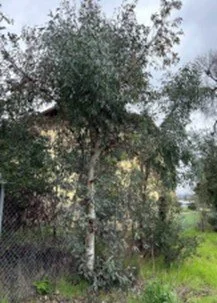Eucalyptus (Tasmanian Blue Gum)
Eucalyptus globulus
Eucalyptus leaves are lance-shaped and can be identified by their strong, camphor-like odor.
Eucalyptus trees are evergreen. They produce copious amounts of plant litter—bark, small branches, and leaves—that create tinder for wildfires, and have shallow root systems (90% of their roots are in the top ONE foot of soil) that make them potential falling hazards. They also contain volatile oils that are highly flammable, and release a large number of seeds after a wildfire, making them potentially even more invasive.
Control Considerations
There are many eucalyptus species, but Tasmanian blue gum is the most common. Eucalyptus plants are not native to California. Not all species of Eucalyptus are invasive, but if any are found outside of a garden, you can assume that they are an invasive species and should be removed if possible.
Eucalyptus will stump-sprout, making them difficult to eradicate. Tarping and/or herbicide treatment of stumps may prevent sprouting. Remove all tree roots when possible. If the soil is moist, weed wrenches can help remove saplings. Limb-up large trees if they are not being removed.
Eucalyptus also reproduces readily from seed.
Bottom left: Young eucalyptus tree.
Bottom left center: Eucalyptus stump-sprouting.
Bottom right center: Eucalyptus bark peels and shreds, creating copious amounts of flammable litter and encouraging trees to ignite.
Bottom right: Eucalyptus leaf, close-up.
Print this ID Card
Learn more about eucalyptus from the California Invasive Plant Council





